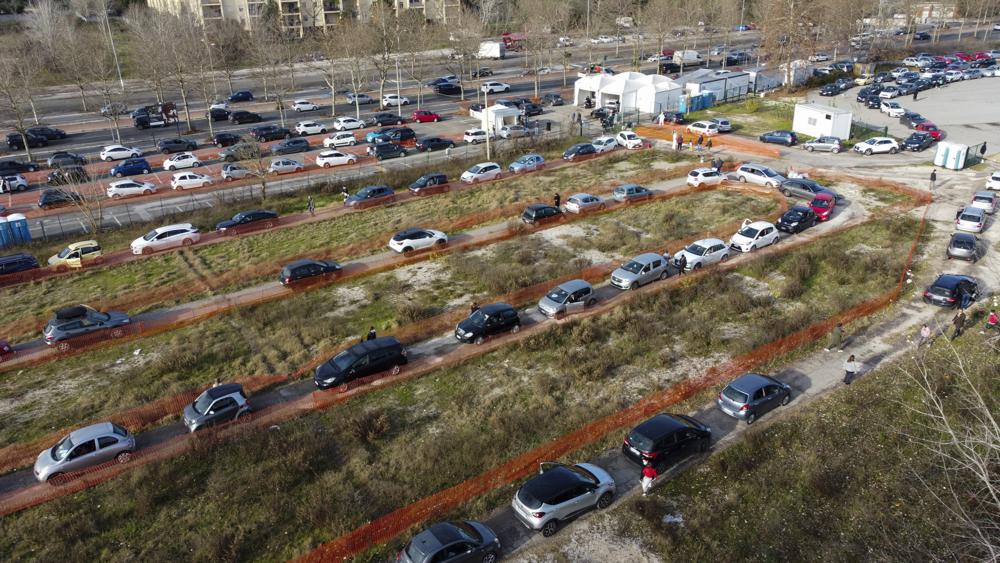Like many people, Alberto Pérez of Madrid used a home test to discover that his headache and cold-like symptoms were caused by COVID-19.
Unable to contact his local health center, where calls went unanswered and online appointments were booked up for the following week, he turned to a hospital emergency room for confirmation. After waiting three hours to be seen, health workers there agreed with his self-diagnosis but provided no PCR test to ensure a more reliable result.
“The nurse seeing me said that, because I had not lost my sense of taste or smell, I had the omicron variant,” said Pérez, 39, who works as an online game developer in the Spanish capital. “But how could she know?”
Overwhelmed by people wanting tests, requiring medication or needing certificates to excuse their absence from work, primary health care services in Spain are operating well past their limit during the current phase of the coronavirus pandemic.
Family doctors are usually the first stop for health care in Europe. They and primary care nurses are viewed as vital to helping prevent sickness, keeping the pressure off hospitals and providing continuity of care.
In a country that only a few weeks ago thought itself relatively safe because more than 80% of the target population is fully vaccinated, the mounting workload in Spain has prompted doctors and nurses to cancel regular checkups for conditions other than COVID-19 and postpone visits to vulnerable people at home.
Because PԿrez’s positive test had been taken at home, neither the hospital nor his local health center would spare the much-needed resources to give him a PCR test. The PCR samples can be sequenced to determine virus variants, something nobody did with Pérez or with many thousands of other positive cases from home tests in Spain.
“You are left with the feeling that there are no resources, that they have no people, and that all they do is cover up the reality by sending people home,” Pérez said.
Caroline Berchet, a health economist at the Paris-based Organization for Cooperation and Economic Development, says primary health care in Europe has been underfunded and understaffed for a long time. The pandemic has simply exposed the resulting frailties in the system.
“Investment in primary health care is not enough across Europe” and beyond, Berchet said. In the 38 OECD member countries, which include the United States, on average only 13% of health spending in 2019 was devoted to primary health care, compared with 28% on in-patient care.
“Primary health care requires better funding and investment in all (OECD) countries,” she said, to ensure more staff, more training, better pay and working conditions, and a more flexible delivery of care.
Paloma Repila, a spokeswoman for SATSE, the biggest Spanish union representing nurses, said that fewer hospitalizations in the current surge mean that many people with milder symptoms are having a “brutal impact” on local health centers.
“Infection rates are so high that we are taking the pandemic out of the health care setting and we are asking people to be their own carers,” she said.
“Individual responsibility is great, but asking people to self-diagnose, to deal with their own medical leave and to be left without any follow-up by professionals, is extremely worrisome.”
In France, years of funding cuts to the public health system are blamed for shortages of doctors in rural areas.
There’s a similar problem in Italy, where general practitioners are feeling the weight of the latest surge as well as the burdens of increased paperwork to certify people are safe to return to work and school, officials say.
Repila, the Spanish union spokeswoman, said authorities should be worried about the consequences.
“If you take the test at home, what variant of the virus do you have? We don’t know,” she said. “Everything, including the length of self-isolation periods, is being decided based on sequencing that isn’t happening.”
Even the daily figures that provide headlines and inform the response by experts and policymakers are once again out of sync, like they were at the beginning of the pandemic. That’s because home test results are not being reported to overwhelmed health centers, either because phones are not being answered, because there are no appointments, or because people are simply not bothering.
Health Minister Carolina Darias last week appealed for people to report their positive tests, even when they show no symptoms or if they decide to stay at home with mild ones.
Unions and other professional groups say medical personnel cannot cope with the number of phone calls, video-assisted consultations and requests for tests, advice, treatment or issuing certificates for people who need to justify an absence from work.
Contact tracing, once viewed as a key to halting the pandemic, is something that has been long forgotten.
Primary care has been out of the media and public attention for much of the pandemic, when most of the concern was focused on the capacity to cope with the flow of patients into hospitals and intensive care units.
But labor groups and professional associations say the problems began much earlier, the result of years of underfunding that has led to many temporary contracts for medical staff and poor health facilities.
After the 2008 European debt crisis, a conservative government in Spain imposed strict austerity measures that meant significant budget cuts for the public health system. Similar cuts occurred elsewhere in Europe.
Spain’s center-left Socialist government last month unveiled a plan to improve the quality and accessibility of primary health care in the next two years. Critics said the move was overdue.
Ten days after completing his quarantine at his Madrid home, Pérez, the online game developer, kept testing positive with home kits but was still struggling to get an appointment with his general practitioner. His health center, which he finally reached by phone, told him to stay home for the New Year’s holiday, and offered a phone call the following week.
“There are no doctors or nurses and then we are left to deal with this on our own,” PԿrez said. “How is that not linked?”
(AP)











